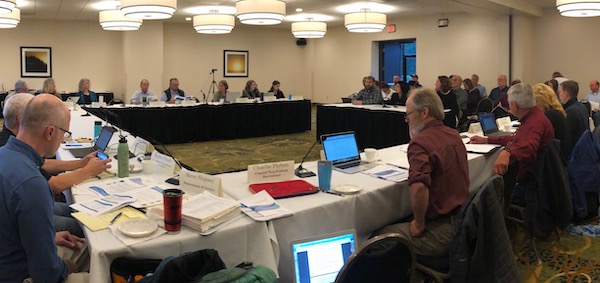
10.28.19
Advisory Council Talks Wind Energy, Whale Entanglement, Marine Debris, Aquaculture & Rocky Habitats!
By Charlie PlybonThe Ocean Policy Advisory Council (OPAC) held their third meeting this year on Monday October 21st in Newport. The packed agenda covered a wide range of topics including offshore wind energy, rocky habitats, marine debris, aquaculture, and whale entanglements. OPAC is a legislatively mandated marine policy advisory council, appointed by the Governor to provide advice on marine resource issues related to Oregon's ocean. The council is made up of a variety of government, tribal, industry and other stakeholder interests. Surfrider Foundation holds a seat representing non-consumptive recreational users on the Council and helps advocate for our chapters and broader recreational interests. Here's a quick wrap of Monday's meeting topics, and always feel free to reach out to Charlie Plybon, Oregon's Policy Manager who represents you on the Council for more information!
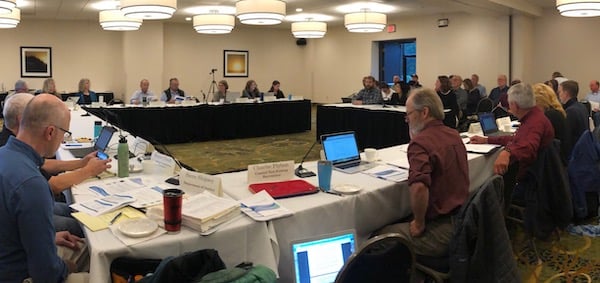 The Ocean Policy Advisory Council hears from the Bureau of Ocean Energy and Management on Wind Energy planning
The Ocean Policy Advisory Council hears from the Bureau of Ocean Energy and Management on Wind Energy planning
Offshore Wind Energy
The Bureau of Ocean Energy Management (BOEM) discussed the growing interest for offshore wind energy in the U.S. BOEM has convened 12 task forces nationwide to discuss renewable energy (more on that in this recent blog post). Currently, there are no lease applications for offshore wind energy developments in Oregon so the conversation is about preparing for potential future applications. Nonetheless, wind energy companies have been pushing projects and wind energy discussions in Coos Bay for years so planning is timely our southern coast communities - where project interest is highest.
OPAC members had some tough questions that proved difficult for BOEM staff to respond to. The comments and questions mirrored those expressed at the Task Force meeting held in Portland in September. OPAC members emphasized the need for the Task Force to be more inclusive, for public comment to be part of their meetings (not after it is adjourned), and meetings should be held on the coast. Further emphasis was put on the need for a clear community engagement process and adequate bonds and plans for mitigation should an offshore wind energy project fail.
Action taken: OPAC voted to send a letter to the Governor's office requesting that an OPAC representative is added to BOEM's Task Force and suggesting that the State engage in upfront planning for offshore wind energy.
 Oregon Policy Manager Charlie Plybon presents OPAC colleague Deanna Caracciolo with Surfrider's USOA flag for her rocky habitat leadership
Oregon Policy Manager Charlie Plybon presents OPAC colleague Deanna Caracciolo with Surfrider's USOA flag for her rocky habitat leadership
Rocky Habitat Management Strategy
Charlie Plybon, Oregon Policy Manager for Surfrider, provided an update on OPAC's Rocky Habitat Working Group (more on the process here). The Working Group, which Plybon chairs, has developed three categories of rocky habitat designations that are goal-driven for an upcoming public process. The types of designations the public will be able to propose (or alter existing) are Marine Research Areas, Marine Gardens (education areas), and Marine Conservation areas. During the proposal process, the public will be able to propose additions, deletions, and adaptations/alterations to existing designations. The draft proposal process (subject to OPAC approval) is outlined here. With the current timeline, proposals are projected to be accepted in April 2020 for approximately three to four months. A really exciting part of this process is the development of a mapping tool to aid in the development of proposals or just to learn more about some of your favorite coastal areas (projected to be available in December 2019).
As part of this process, Surfrider chapters have developed their own position statement and guiding principles for the special rocky habitat designations. This was developed through a process that included outreach and dialogue with all of our chapters throughout Oregon and we think speak highly to the consensus of many in the recreational community - Read Surfrider Oregon's Rocky Habitat Statement.
Find out more on the state's Rocky Habitat page here!
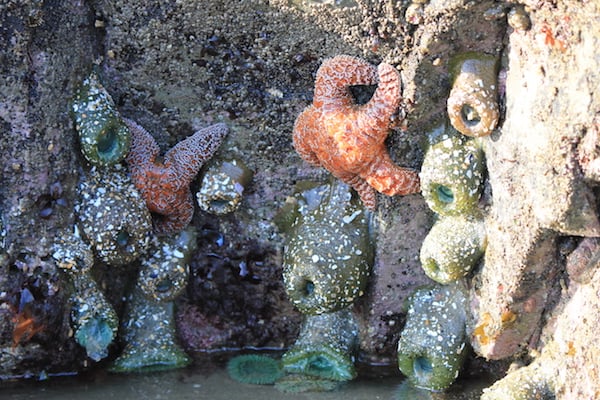 A stunning array of seastars and anemones adorn a low tide wall at Otter Rock. Rocky Habitats are important to Oregon number of reasons from providing resilient, diverse ecological communities to research, education and discovery!
A stunning array of seastars and anemones adorn a low tide wall at Otter Rock. Rocky Habitats are important to Oregon number of reasons from providing resilient, diverse ecological communities to research, education and discovery!
Marine Debris
Nir Barnea, Pacific Northwest Regional Coordinator for the NOAA Marine Debris Program, provided an update on the Oregon Marine Debris Action Plan – a process that began in 2015. The first Action Plan was published in 2017 and was recently updated in September 2019. With marine debris and plastic pollution being a key issue for Surfrider foundation members, Surfrider advocated heavily to identify marine debris as an OPAC priority in 2016. Following that advocacy leadership on marine debris, we later chaired the working group within OPAC for the action planning process. Fast forward three years now and the Action Plan has helped to steer NOAA MDP funding towards important marine debris projects in Oregon including multiple derelict vessel mapping and removal efforts, a statewide marine debris action day, marine debris research and prioritization workshops, and multiple cleanup and prevention programs. These are things that Surfrider is extremely proud of helping to play a leadership role for our state on. Another workshop will be held in 2021 to update the Action Plan.
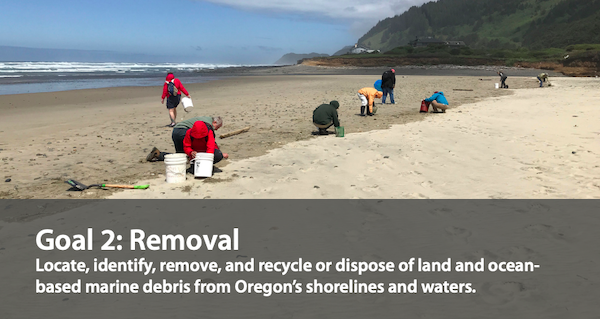 A snapshot from inside of
Oregon's 2019 Marine Debris Action Plan. Prevention and Removal are the primary goals with shared objectives, actions and coordinated strategies.
A snapshot from inside of
Oregon's 2019 Marine Debris Action Plan. Prevention and Removal are the primary goals with shared objectives, actions and coordinated strategies.
Aquaculture
Gil Sylvia, Professor Emeritus at Oregon State University, provided an update to the Council on the growing national investments in the Aquculture Industry. Aquaculture is the growing, breeding and harvesting of plants and animals in water - essentially, it's agriculture or farming in water. Seafood is the number one source of protein in the world, and aquaculture supplies more than half of the world's seafood. Oregon has approximately 50 aquaculture operations growing oysters, fresh water fish, and dulse. Dulse (known popularly as the seaweed that tastes like bacon) is expanding in Oregon while public aquaculture (i.e. salmon and trout for recreational fisheries) remains the number one form of the industry in Oregon.
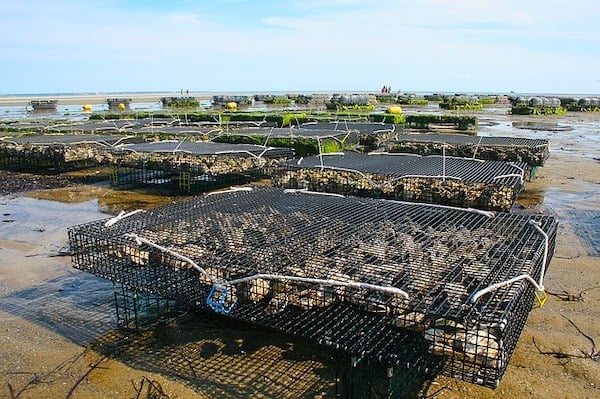
Nationally, Oregon ranks sixth in oyster production and from an overall aquaculture standpoint, Oregon production is far less than its neighboring states, including Idaho. According to the U.S. Department of Agriculture, Oregon is in last place in terms of realizing the state's aquaculture potential - thus, there's some economic interest in investing in aquaculture in Oregon (and nationally). A number of underway and potential aquaculture projects covered included:
USDA Research/Breeding Center: The USDA Agricultural Research Service has proposed the creation of a West Coast Shellfish Research, Genetics, and Breeding Center to be located at Hatfield Marine Science Center in Newport. This Center would focus on research related to shellfish disease, production, and more. The proposal is pending approval through federal legislation.
Oregon Aquaculture Association recently received a grant to boost investment in aquaculture by developing a GIS-based financial investment tool. There is a lot of interest at Oregon State University to work more strategically on aquaculture and Oregon Sea Grant is adding a new extension agent who will focus on aquaculture.
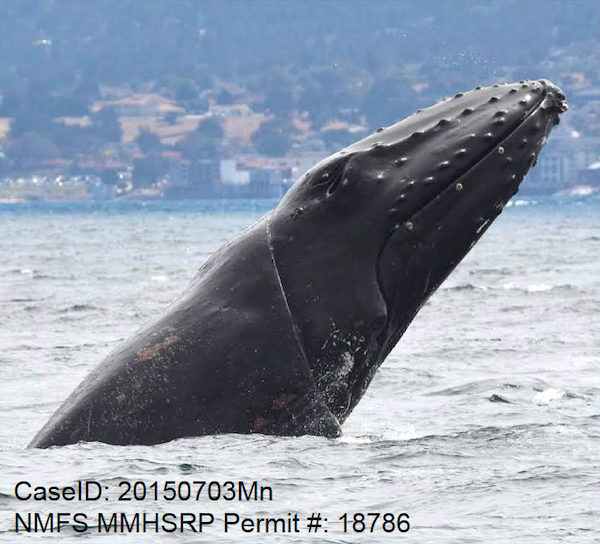 Whale entanglements, particularly with humpbacks, have been on the rise along the West Coast of the United States since 2014. Photo: Oregon Department of Fish and Wildlife whale entanglement presentation to OPAC
Whale entanglements, particularly with humpbacks, have been on the rise along the West Coast of the United States since 2014. Photo: Oregon Department of Fish and Wildlife whale entanglement presentation to OPAC
Whale Entanglement
Caren Braby, Manager of the Marine Resources Program for the Oregon Department of Fish and Wildlife, provided an update on the issue of whale entanglement in Dungeness crab gear. Humpbacks, which are listed as Endangered/Threatened (depending on the population of Humpback), migrate through Oregon's waters. The Marine Mammal Protection Act sets a limit on how many whales can be seriously injured or killed without seriously damaging a population (called the Potential Biological Removal). Currently, the West Coast is exceeding this. Further, the Endangered Species Act prohibits any take or entanglement without a permit.
Beginning in 2014, the number of confirmed whale entanglements drastically increased. The increase was mainly with humpback whales. Half of entanglements from 2013-2018 were from unidentified fisheries while approximately 30% of entanglements were with Dungeness fishing gear (both commercial and recreational). In the last 10 years, there have been more humpback entanglements in Oregon fishing gear than in previous years. To date, there have been no more than two humpbacks entangled in Oregon fishing gear in one year. However, gear from CA and WA combined accounted for upwards of 50 a year.
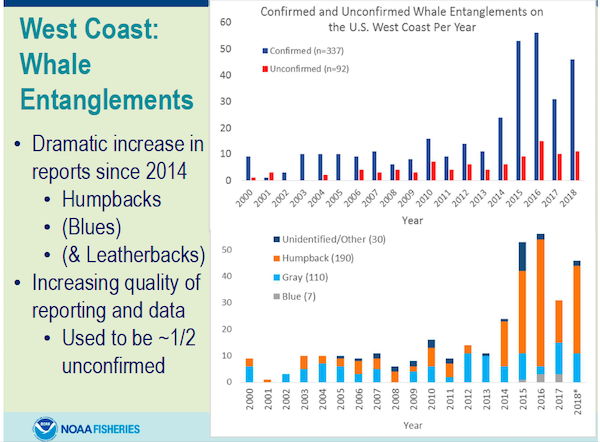
There have been several actions in the past 10 years to address entanglements. In 2017, the Oregon Whale Entanglement Working Group was developed to find strategies to decrease entanglements. A phased approach to potential management measures began this year. Phase one was learning more from entanglement events while phase two will focus on reducing risk of entanglement.
The Center for Biological Diversity sued the State of California for operating the Dungeness crab fishery without an incidental take permit under the Endangered Species Act. As a result of the settlement for this lawsuit, the CA Dungeness fishery closed several months early, on April 15. In 2020, the fishery will also close early (on April 1). This means for Oregon moving forward, the State needs to design whale entanglement management measures to reduce risk. These management decisions need to take into consideration changing ocean conditions that may become the new normal. These changing conditions have caused humpbacks to change their eating patterns and target food, bringing them closer into shore and making it more likely for them to interact with Dungeness fishing gear.
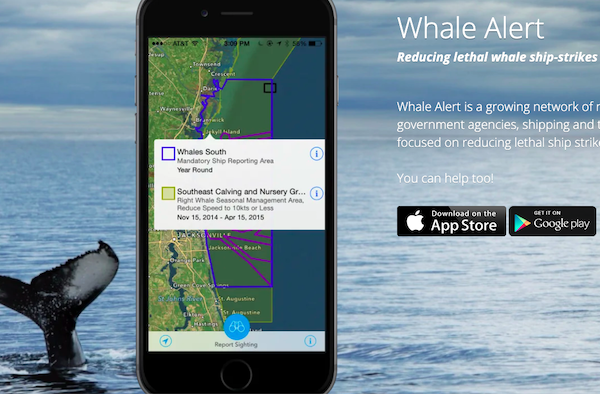 The
Whale Alert App. is a great way for mariners, boaters and those on the ocean to help identify whales and reduce the risk of entanglements
The
Whale Alert App. is a great way for mariners, boaters and those on the ocean to help identify whales and reduce the risk of entanglements
A major focus of the Oregon Whale Entanglement Working Group is to identify when and where whales are being seen off the coast of Oregon. Humpbacks have been spotted between 50 and 1,000 meters. Boaters can help with this study by downloading the Whale Alert Mobile App.
DO NOT try to free an entangled whale - it is extremely dangerous. Report entangled whales by calling 877-767-9425.
